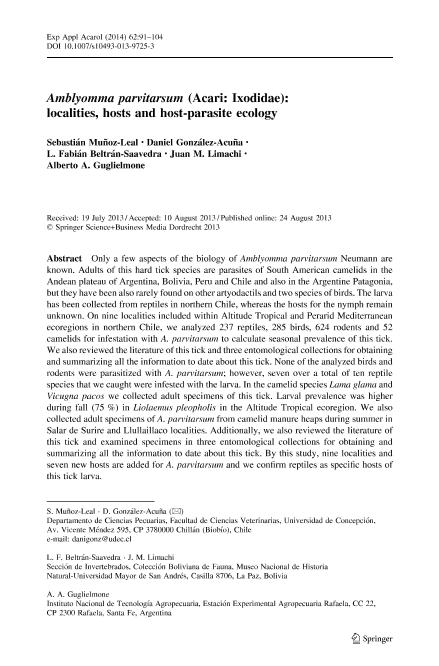Mostrar el registro sencillo del ítem
dc.contributor.author
Muñoz Leal, Sebastian
dc.contributor.author
González Acuña, Daniel
dc.contributor.author
Beltrán Saavedra, L. Fabián
dc.contributor.author
Limachi, Juan M.
dc.contributor.author
Guglielmone, Alberto Alejandro

dc.date.available
2017-05-04T19:29:57Z
dc.date.issued
2014-01
dc.identifier.citation
Muñoz Leal, Sebastian; González Acuña, Daniel; Beltrán Saavedra, L. Fabián; Limachi, Juan M.; Guglielmone, Alberto Alejandro; Amblyomma parvitarsum (Acari: Ixodidae): localities, hosts and host-parasite ecology; Springer; Experimental And Applied Acarology; 62; 1; 1-2014; 91-104
dc.identifier.issn
0168-8162
dc.identifier.uri
http://hdl.handle.net/11336/15995
dc.description.abstract
Only a few aspects of the biology of Amblyomma parvitarsum Neumann are known. Adults of this hard tick species are parasites of South American camelids in the Andean plateau of Argentina, Bolivia, Peru and Chile and also in the Argentine Patagonia, but they have been also rarely found on other artyodactils and two species of birds. The larva has been collected from reptiles in northern Chile, whereas the hosts for the nymph remain unknown. On nine localities included within Altitude Tropical and Perarid Mediterranean ecoregions in northern Chile, we analyzed 237 reptiles, 285 birds, 624 rodents and 52 camelids for infestation with A. parvitarsum to calculate seasonal prevalence of this tick. We also reviewed the literature of this tick and three entomological collections for obtaining and summarizing all the information to date about this tick. None of the analyzed birds and rodents were parasitized with A. parvitarsum; however, seven over a total of ten reptile species that we caught were infested with the larva. In the camelid species Lama glama and Vicugna pacos we collected adult specimens of this tick. Larval prevalence was higher during fall (75 %) in Liolaemus pleopholis in the Altitude Tropical ecoregion. We also collected adult specimens of A. parvitarsum from camelid manure heaps during summer in Salar de Surire and Llullaillaco localities. Additionally, we also reviewed the literature of this tick and examined specimens in three entomological collections for obtaining and summarizing all the information to date about this tick. By this study, nine localities and seven new hosts are added for A. parvitarsum and we confirm reptiles as specific hosts of this tick larva.
dc.format
application/pdf
dc.language.iso
eng
dc.publisher
Springer

dc.rights
info:eu-repo/semantics/openAccess
dc.rights.uri
https://creativecommons.org/licenses/by-nc-sa/2.5/ar/
dc.subject
Amblyomma Parvitarsum
dc.subject
Distribution
dc.subject
Ecology
dc.subject
Hard Ticks
dc.subject
Host-Parasite Relationship
dc.subject.classification
Ciencias Veterinarias

dc.subject.classification
Ciencias Veterinarias

dc.subject.classification
CIENCIAS AGRÍCOLAS

dc.title
Amblyomma parvitarsum (Acari: Ixodidae): localities, hosts and host-parasite ecology
dc.type
info:eu-repo/semantics/article
dc.type
info:ar-repo/semantics/artículo
dc.type
info:eu-repo/semantics/publishedVersion
dc.date.updated
2017-04-17T19:26:57Z
dc.identifier.eissn
1572-9702
dc.journal.volume
62
dc.journal.number
1
dc.journal.pagination
91-104
dc.journal.pais
Países Bajos

dc.journal.ciudad
Dordrecht
dc.description.fil
Fil: Muñoz Leal, Sebastian. Universidad de Concepción; Chile
dc.description.fil
Fil: González Acuña, Daniel. Universidad de Concepción; Chile
dc.description.fil
Fil: Beltrán Saavedra, L. Fabián. Universidad Mayor de San Andres; Bolivia
dc.description.fil
Fil: Limachi, Juan M.. Universidad Mayor de San Andres; Bolivia
dc.description.fil
Fil: Guglielmone, Alberto Alejandro. Instituto Nacional de Tecnología Agropecuaria. Centro Regional Santa Fe. Estación Experimental Agropecuaria Rafaela; Argentina. Consejo Nacional de Investigaciones Científicas y Técnicas; Argentina
dc.journal.title
Experimental And Applied Acarology

dc.relation.alternativeid
info:eu-repo/semantics/altIdentifier/doi/http://dx.doi.org/10.1007/s10493-013-9725-3
dc.relation.alternativeid
info:eu-repo/semantics/altIdentifier/url/https://link.springer.com/article/10.1007%2Fs10493-013-9725-3
Archivos asociados
